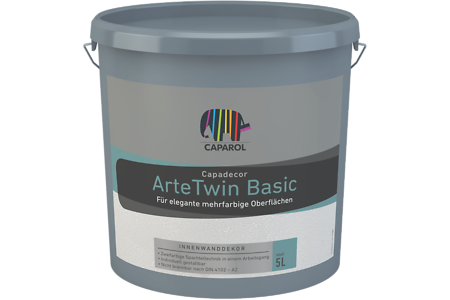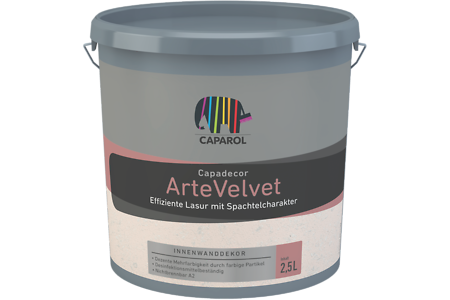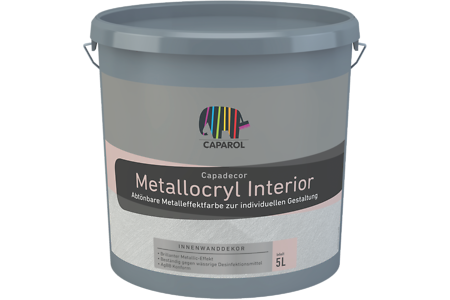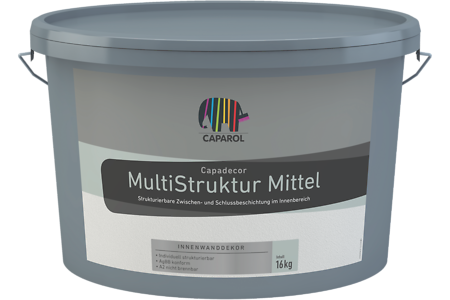Field of Application
Specially developed, highly attractive glaze (scumble) for interior wall surfaces.
The glaze consists of bright pigmented particles, which do not mix with other colour pigments after tinting. On bright substrates they create a high-grade, sophisticated visual appearance.
Material Properties
- Water-dilutable, ecologically compatible, low odour.
- Wet scrub resistance Class 2.
- Safe application.
- Resistant to aqueous disinfectants.
- Tintable via ColorExpress.
Material Base / Vehicle
Acrylic resin emulsion/dispersionPackaging/Package Size
2.5 litres and 5 litres
Colours
Transparent with white particles.Tinting:
ArteLasur can be tinted via ColorExpress in approx. 350 colour shades following the Caparol 3D-System plus. Please note: All colours must be selected from the special ColorExpress colour collection "CD ArteLasur". Colour shades of applied glazes on walls might be different from the original hues of Caparol 3D-System plus due to their semi-transparent/translucent characteristics, application method, applied film thickness and colour of the substrate to be coated.
Gloss Level
Silk-matt (mid sheen) after drying.Storage
Keep in a cool, but frost-free place.
Keep partially used containers always tightly closed.
Density
Approx. 1.0 g/m³
Supplementary Product
- Capadecor DecoGrund
- MultiStruktur Fine / Medium / Coarse / Extremely Coarse
- Metallocryl Interior
- Pearl White
- Switch Desert
- Switch Lagoon
Suitability according to Technical Information No. 606 Definition of Application Areas
| Interior 1 | Interior 2 | Interior 3 | Exterior 1 | Exterior 2 |
| + | + | ○ | – | – |
| (–) inapplicable / (○) of limited suitability / (+) suitable | ||||
Suitable Substrates
Interior walls and ceilings. Also suitable for use on floor spaces within the Disboxid ArteFloor System (follow corresponding System Data Sheet).The substrate must be sound/stable, dry, clean, and free from all substances that may prevent good adhesion. In Germany: Follow VOB, part C, DIN 18363, section 3.
Do not apply Capadecor ArteLasur on an alkaline substrate.
Substrate Preparation
Gypsum and Ready-Mixed Plasters in Mortar Group/Class PIV:
Apply one priming coat of Capadecor DecoGrund. Sand/grind off sintered skin, remove all sanding dust and prime with Tiefgrund TB.
Gypsum Wallboards:
Apply one priming coat of OptiGrund or Tiefgrund TB on absorbent boards.
Prime highly compact (dense) and smooth boards with Capadecor DecoGrund to enhance bonding.
Gypsum Plasterboards (Sandwich-Type Plaster Boards/Drywalls):
Sand/grind off filler (mortar) burrs. Strengthen soft and sandpapered gypsum areas with Tiefgrund TB. Apply one priming coat of Capadecor DecoGrund, OptiGrund or CapaSol. Boards containing water-soluble, discolouring substances that leave marks must be primed with AquaSperrgrund.
In Germany: Follow BFS Data Sheet No. 12.
Concrete:
Remove all parting agent (formwork oil residues) and chalking or sanding substances.
Treat the surface with a fluosilicate solution in order to reduce alkalinity, if necessary.
Facing Brickwork and Fair-Faced Sand-Lime Brick Masonry:
Treat with a fluosilicate solution in order to reduce alkalinity, if necessary.
Sound/Stable Existing Coatings:
Rework matt, slightly absorbent coatings without pre-treatment. Roughen (sand) glossy/shiny surfaces and enamel coatings. Apply one priming coat of Capadecor DecoGrund.
Unstable Existing Coatings:
Remove unstable coatings of enamel and dispersion/emulsion paint or synthetic (organic) plaster. Apply one priming coat of Capadecor DecoGrund on slightly absorbent, smooth surfaces. Prime highly porous, sanding or absorbent surfaces with OptiGrund or CapaSol.
Remove unstable coats of mineral paint by mechanical means and remove all sanding dust. Apply one priming coat of Tiefgrund TB.
Coats of Glue-Bound Distemper (Limewater Colour/Paint):
Wash off the existing distemper very thoroughly, allow to dry and prime with Tiefgrund TB.
Uncoated Wood-Chip/Ingrain, Relief or Embossed Wallpapers and Wallcoverings:
Coat without pre-treatment.
Non-Adherent Wallpapers:
Remove wallpapers completely and wash off glue and residues of waste paper. Apply one priming coat of Tiefgrund TB.
Mildewed/Mouldy Surfaces:
Remove fungal attack (fungi/mildew/mould) by wet cleaning, then use Capatox or FungiGrund and allow to dry thoroughly. Prime according to the type and condition of the substrate, in compliance with legal/local and official regulations (follow e.g. Ordinance of Biocidal Agents and Ordinance on Hazardous Substances).
Surfaces Stained with Nicotine, Water, Soot or Fat/Grease:
Remove nicotine, soot or fat/grease stains by washing with tap water, adding a fat-dissolving household detergent, then allow the substrate to dry thoroughly. Clean dried-up water spots by dry brushing-off. Apply one insulating coat of Caparol AquaSperrgrund.
Wood and Derived Timber Products:
Coat with waterborne, ecologically compatible Capacryl acrylic enamels or Capacryl PU enamels.
Small Defects:
After having completed the necessary preparations, repair defects with Caparol-Akkordspachtel in accordance with our processing specification and prime subsequently, if necessary.
Designing Guidelines:
The substrate must always be free of any colour contrast.
Wall glazes are semi-transparent/translucent products, hence colour and texture of the substrate will remain slightly noticeable after drying. Therefore a trial application on site and approval by the final customer is essential.
In case of very bright-toned glaze and on noticeably textured substrates, the bright pigmented particles in the glaze can show only a limited visual effect.
The contrasting effect is high, when a darkly tinted glaze is applied on a light-coloured priming coat.
Untinted ArteLasur can be applied on dark-coloured substrates.
Noble surfaces are achievable by adding 1 % up to 5 % of effect pigments. Stir the nacreous pigments thoroughly into the product to ensure a homogeneous mixture. Follow Technical Information No. 816.
Surface Coating System
Intermediate Coat (to obtain smooth surfaces):
- Capadecor DecoGrund
Intermediate Coat (to obtain textured surfaces):
- Multistruktur Fine, Medium, Coarse or Extremely Coarse
Finishing Coat:
ArteLasur is adjusted ready-to-use and should be applied undiluted. Recommendation: Apply the glaze with a soft brush (e.g. whitewash brush or oval-formed brush) on the full surface (short cross-coat application). After a short flash-off time, the surface can be spread/blended using a soft, dry wiper or wallpaper brush. Depending on the desired look it can be additionally coated wet-on-wet with tinted product or after drying of the first shade. A second glaze application enhances colour intensity, number of bright particles and loading capacity of the surface. A second application of ArteLasur (without tinting) enhances the number of particles and colour intensity.
 |  |  |
| Brush applied priming coat (cross-coat) or intermediate coat, if necessary. Alternatively apply by paint roller and spread crosswise. | After drying: Apply ArteLasur (short crosswise brush application). | After a short flash off time the surface is spread/blended using a soft, dry wiper or brush to enhance the effect of bright particles. |
Please Note:
Priming and intermediate coats should be brush applied or treated by brush when roller applied, in order to avoid visible roller marks.
Consumption
Approx. 110 - 170 ml/m2 per coat.Application Conditions
Lower Temperature Limit for Application and Drying:+5 °C for product, ambient air and substrate.
Drying/Drying Time
At +20 °C and 65 % relative humidity surface-dry after approx. 4 hours.Tool Cleaning
Immediately after use with water and soap.Please Note (Status as at Date of Publication)
Keep out of reach of children. Ensure good ventilation during use and drying. Do not eat, drink or smoke while using the paint. In case of contact with eyes or skin, immediately and thoroughly rinse with water. Do not allow product to enter drains, waterways or soil.Further information: See Material Safety Data Sheet (MSDS).
Contains: 1,2-benzisothiazol-3(2H)-one, 2-methyl-2H-isothiazol-3-one. May produce an allergic reaction.
In Germany: Advice for allergy sufferers with isothiazolinone allergy: Hotline 0180/5308928
(0.14 €/minute from German landline, MTS max. 0.42 €/minute).
Disposal
Materials and all related packaging must be disposed of in a safe way in accordance with the full requirements of the local authorities. Particular attention should be made to removing wastage from site in compliance with standard construction site procedures.In Germany: Only completely empty buckets/containers should be handed in for recycling. Dispose containers with residues of liquid product via waste collection point accepting old paints and enamels. Dispose dried/hardened product residues as construction site/demolition/municipal or domestic waste.
EU limit value for the VOC content
of this product (category A/l): max. 200 g/l (2010). This product contains max. 50 g/l VOC.Product Code Paints and Enamels
M-DF02 (Germany)Substances of Content - Declaration
Acrylic resin dispersion/emulsion, mineral fillers, water, film forming agent, additives, preservatives (Methyl-, Benzisothiazolinone).Customer Service Centre
Tel.: +49 6154 71-71710Fax: +49 6154 71-71711
e-mail: kundenservicecenter@caparol.de
International Distribution: Please see www.caparol.com










